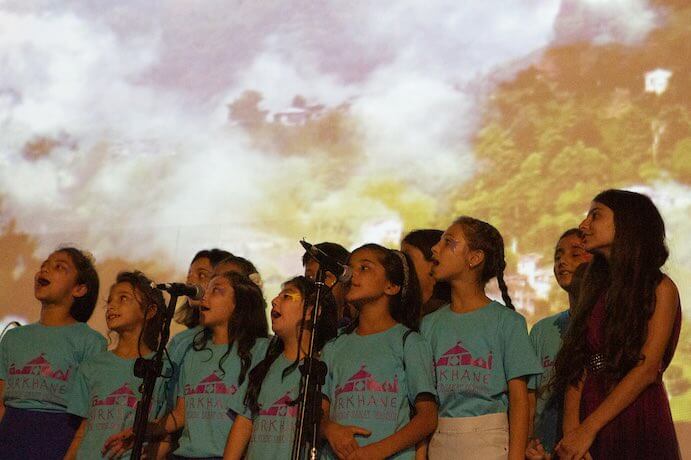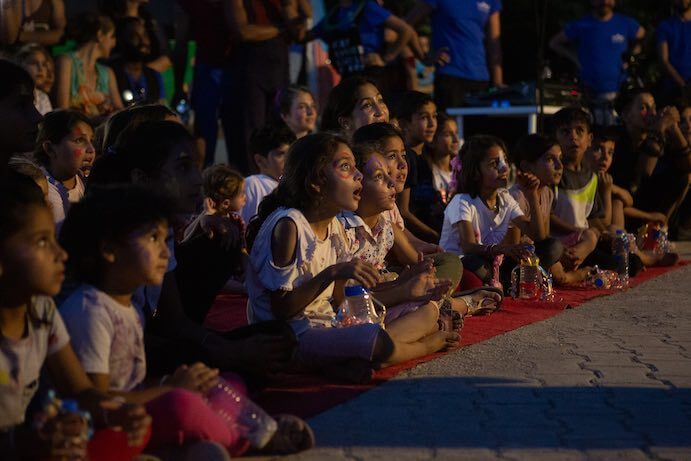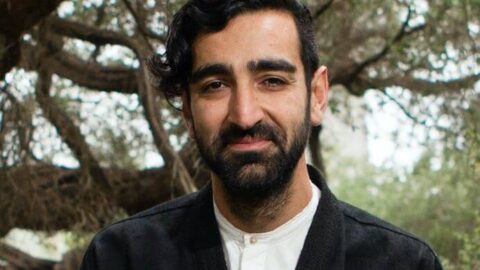Sahba Aminikia is an Iranian-American composer, pianist, and educator born in post-revolutionary wartime in Iran. Aminikia first explored immersive, visceral music in a successful performance career before pivoting to artistic direction of Flying Carpet Festival, an international music festival serving refugee children in Turkey. At time of writing, Aminikia’s birth country Iran is experiencing significant and violent upheaval. ICIYL offers particular thanks to Sahba for his generous work and shares hope for peace and restoration in Iran, Turkey, and its neighboring region.
You left an established compositional and academic life behind in San Francisco to launch Flying Carpet Children Festival in Mardin, Turkey for some 5,000 child refugee residents. In partnership with Müzikhane (House of Music) and Sirkhane Social Circus School, the Festival entertains and educates children affected by war and social trauma using circus artists, multi-media producers, trance dancers, traditional Kurdish musicians, acrobats, fire dancers, trapeze artists, jugglers, and hula hoopers! What was your experience with circus arts and music before this? What was your learning curve?
I have to emphasize that this project is not just a humanitarian project and is in fact a continuation of what I have been doing compositionally and artistically until now. I had absolutely no prior experience with circus arts and did not know of the possibility of it being used as a healing method for individuals afflicted by trauma. I studied at San Francisco Conservatory of Music, an excellent classical music conservatory, and their holistic approach to academic music was very inspiring to me, as were the incredible professors that I met there, including Dr. Nikolaus Hohmann and David Garner. I graduated in 2013 and came across Sirkhane Social Circus School by accident a few years ago and started following and observing their process on social media. Consistency, muscle memory, focus, repetition, and internalization are essential factors of circus arts as well as music. However, circus artists can practice with little to nothing. This is very different from music, which requires an established environment and instruments.
Considering the communities that we are working with near the Turkish-Syrian border, the presentation of arts is extremely different than more privileged societies, such as Western countries. If the presentation is dry and traditional, the level of engagement among our type of audience diminishes significantly. For example, the performance of a Mozart Sonata might seem boring and not engaging for our audience, but when it is combined with performance acts, such as circus, dance, or puppetry, in addition to projections on the 1,500-year-old walls of Dara Ruins in Mesopotamia and designed lighting, the experience immediately transforms into something powerful that can significantly improve their life conditions. This type of performance is far more cathartic for people who are desperately in need of a collective moment of release. I am even working on a composition in which a choreographed circus performance by our children is incorporated as a method of self-expression synchronized with the music. I am still learning and experimenting.
These children struggle to preserve childhood in the face of loss, child marriage and labor, and poor integration into Turkey’s language and educational system. Flying Carpet Festival and Müzikhane gives story-telling skills so these children can express themselves in meaningful ways. What are recurring themes of the stories these children tell, and what surprises you in their self-expression?
Storytelling as a life skill or as an artistic expression tool is an incredibly powerful tool for the children and can be reflected through music, circus, dance, photography, and art. But from a larger perspective, engaging children in an artistic effort which has been carved out of nothing and grown into a larger collaborative effort develops a sense of identity and strong inner beauty inside those children, which is reflected in many aspects of their daily lives. The main qualities of child’s art are a pure passion for life, a strong desire to be heard, and a desire to be singled out as a unique individual. Children normally capture the world through the lenses of their families and their communities, and when they regularly attend our centers and meet our artists, another stream of individuality starts to grow inside them, which offers them the option of being different and weird, the option of preserving their strangeness and extending their boundaries.

Flying Carpet Festival incorporates social circus pedagogy; Müzikhane (House of Music) is described as a social musical school, and Sirkhane (House of Circus) is a social circus school founded by an artist and social worker, Pinar Demiral. What does “social” mean here, and where have you found fertile edges between artistic practice and clinical work?
I think what we mean by “social” is the integration of arts into a society, where they can function as a holistic method for the residents who have suffered from traumatic experiences. I believe that the roots of performance arts lie in creating a collaborative effort towards beauty, the creation process of which is extremely cathartic for both artists and audiences but in different ways. That is what I call a successful experience/piece of art. In societies such as the ones where we are working, these moments of beauty and catharsis are extremely rare to non-existent due to lack of access. Also, as a platform for social arts, our centers provide an opportunity for a child to be involved in this process and be a part of a collaboration. What is intriguing for me in this process is to come up with creative musical solutions to engage musically untrained children, sometimes even with no knowledge of reading and writing, in a meaningful creative process. My friends and I came up with numerous solutions of such kind to engage children in our dedicated sets at the festival.
What I seek in my composing process which is similar to Flying Carpet Festival, is to reflect and capture stories that already exist in my surroundings and find the closest thing to a balance between educating the audience and engaging them fully in an immersive magical experience. This process goes back to the roots of the word “magic” in Zoroastrianism, the ultimate goal of which is keeping the fire of hope burning for thousands of years. The arts are there to bring hope and relief to human societies in my view, so I think providing and sustaining hope is that fertile edge that you are talking about.
The school cultivates each child’s innate beauty and confidence via a “non-political, non-religious, and non-ideological method,” but you have also had a beautiful collaboration composing a sacred choral work for the Afghan National Institute of Music (ANIM). How do you navigate religious dialogue and transcendent expression in these complicated contexts?
I think purity, in the way that children imagine it, is far more sacred than how religion portrays divinity. Adding any flavor of organized ideology like religion or politics to a piece such as the one you mentioned can diminish the transcendent effect of their voices, which by themselves are effective and striking enough. The text for the piece was also based on three lullabies from three different regions of Iran, and anyone can connect with the idea of a lullaby and the divinity behind it.
This process very much resembles our work in Mardin, which is required to be non-political, non-religious, and non-ideological for it to sustain through governmental changes in a geo-politically unstable area. Universal humanity and honesty are the values that we encourage among our children at Sirkhane and Müzikhane.

You have commented on how the Flying Carpet Festival reset your perspective on music-making, privilege, and ethical impulses. It seems many Western musicians desire to be more useful, but struggle with integrating their personal ambition with actual social needs. What candid suggestions would you offer Western musicians in their artistic practices, careers, and systems?
I recommend that my friends and colleagues expand their view of themselves and try to see how effective they can be in more deserving communities, if effectiveness and social awareness is what they seek in their artistic career. Forming a social or political opinion in one’s art without being in touch with reality seems superficial to me.
The world of today has changed immensely compared to the time where music was solely performed at opera houses, gigantic theatres, and concert halls. There is a large population of the world who have little-to-no access to cultural opportunities or any notion of beauty, and this is where the majority of horrendous events such as war and terrorism occur. Children growing up in these areas have no means of expressing themselves except through violence and terrorism ,which if you think about it, are perverted forms of expression, as well.
My advice to other artists is to not get stuck in what the arts establishment dictates to them and ignore what is expected of them by their friends, parents, colleagues, teachers and the previous generation of artists. How about starting something TRULY new, stupidly idealistic, and exactly as you imagine the world should be in your dreams? This, in my opinion, puts one’s artistic ambitions and the social needs of their communities in line with each other and creates a healthier artistic process more in touch with humanity.
In the end, I would like to mention that you also have always a place with us if you’d like to join our festival next year: www.flyingcarpetfestival.org
























